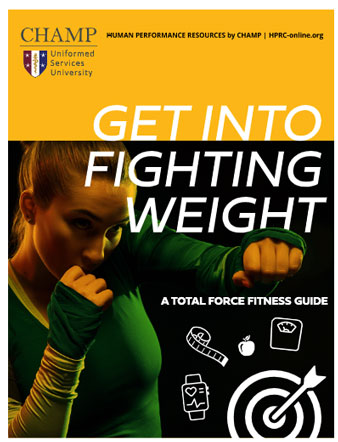Fighting Weight
CHALLENGE 1: Assess your habits to create a holistic weight loss plan
- CHALLENGE 1: Assess your habits to create a holistic weight loss plan
- TASKS to achieve Challenge 1
- Additional resources: Challenge
CHALLENGE 1: Assess your habits to create a holistic weight loss plan
Your first challenge, should you choose to accept it, is to assess your current health habits as they relate to sleep, stress, exercise, and diet. The rest of the challenges can be completed in any order, but it’s important to start with this one. You’ll be able to use this workbook more effectively—and ultimately achieve your weight-loss goals—if you first identify your strengths and areas for improvement and then set a solid goal.

The first part of Challenge 1 is to record your habits for a week. Use the habits tracking sheet in the Tasks section below to record 4 things every day for one week:
- How many hours of sleep did you get last night? (Shoot for 7–9 hours.)
- How much exercise or physical activity did you get today? (Aim for 30+ minutes of moderate exercise.)
- How many fruits and vegetables did you eat today? (Aim for 4–5 servings each day.)
- How would you describe your mood today?
“Use HPRC’s Strategic Habits Workbook for a comprehensive guide to help you to develop good habits to optimize your weight loss and fitness goals”
At the end of the week, assess how you did. Compare your results to the recommendations on the tracking sheet. Where did you fall short? What areas can you improve on? In some cases there isn’t necessarily a right answer, such as how you felt on a given day.
The goal isn’t to be perfect with every habit every day but to be mindful of your health habits and make small adjustments where you can.
Once you’ve reviewed your habits, set up SMART goals to look for areas of improvement so you’re more likely to achieve your weight-loss goals.
Specific
Measurable
Achievable or Actionable
Relevant
Time sensitive
Rather than just saying “I want to lose weight,” SMART goals help you map out how you’ll get there. A good SMART goal might sound like, “I will lose 15 pounds in the next 12 weeks by starting to implement healthier choices, because I need to pass my PT test.”
You’ll set other SMART goals along the way to help you achieve your primary weight-loss goal, but this is a good start. Use the SMART-goal worksheet below to help you set up your initial weight-loss goal before you get started on the other challenges. This will establish a starting point for any changes—large or small—you want to make to improve your health.
TASKS to achieve Challenge 1
- Create new habits to help you lose weight.
- Track your habits so you can tailor your weight-loss goals.
- Get SMART about setting goals—and reap the rewards.
- Use this worksheet to set your SMART goals for weight loss.
- Learn a few tips to help build your motivation to lose weight.
Additional resources: Challenge 1
Find more resources to help you assess your current health habits.
Calculate calories from foods: Calorie Control Council
Food-diary apps to keep you on track NIH body weight planner
Track eating: 3-day food record USDA: DRI calculator
USDA: My plate plan
A PDF version of the full Get into Fighting Weight: A Total Force Fitness Guide (PDF) is available for download.
